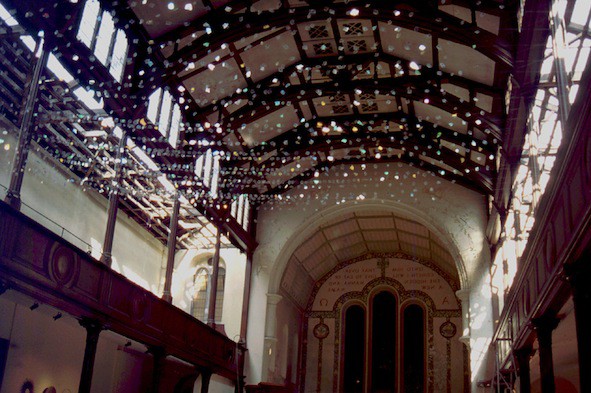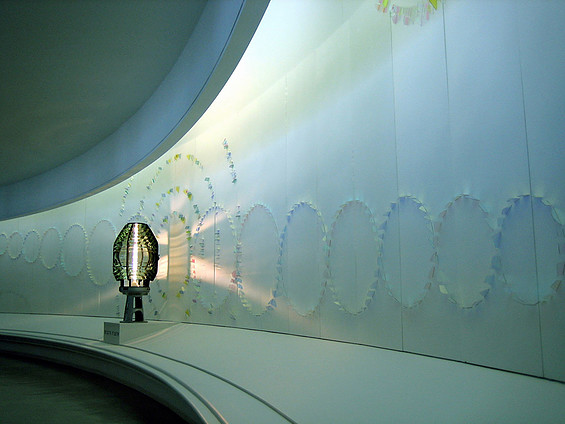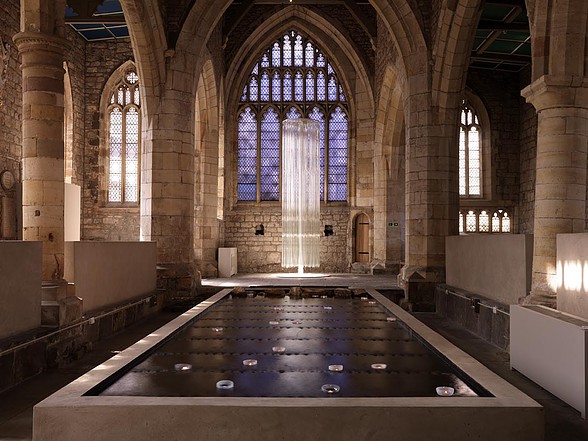Vanessa Cutler has a wide range of skills in glass, thanks to her thorough education.
Through her talk she covered the extensive training she has received in regards to her glasswork. She began by discussing her initial training in Swansea, where her focus on traditional stained glass saw her develop a focussed approach to her working technique. But she was quick to realise that hand cutting glass can never be perfect every time and is very rarely the same as before. Here she was trained in restoration and traditional skills, but was expected to expose herself to more contemporary work. Through live commissions that were enforced during her study, Cutler was already gaining experience with public art.
Cutler went on to explore glass in Wolverhampton, where she discovered kiln forming and glass blowing. Her time working with public commissions in Swansea became advantageous as she started collaborating with other artists. Cutler’s first collaborative piece was created with Stuart Garford, which saw the production of ‘Glass Throne’.
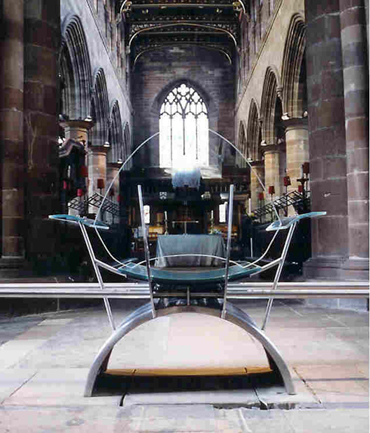
Cutler then went on to regularly collaborate with other artists to create art. She is aware that even if her name is not present on the work itself, that it could not have been realised without her involvement and expertise. Through the development of internet communication she is able to expose her techniques to a wider audience, gaining collaborative contracts over an international range.
She has an impressive level of experience in various areas of glass. At her time in Wolverhampton, as well as her work in glass restoration, Cutler designed and created couture jewellery to support herself financially. Creating a series of one hundred hat pins, she was even able to give one to the Queen.
Her work with jewellery resulted in her interest with finish and attachments of glass and how the cliental can be narrowed according their requirements. Cutler was learning how to sell her work, considering mark-ups and costing within the market.
Cutler’s first commission was for Norwich Castle Museum, where she was able to utilise her skills to layer glass whilst mixing enamels to create a piece which covered all the requirements of the client brief. Her interest in fixings saw her experiment with nylon to fix the pieces together. She explained how her training had taught her to always listen to the client but to ensure she only presented something she was proud of, considering style, concept and narrative.

Cutler explained how important it is to network in the industry. Talking to people from other areas which you may not have experience in can be very beneficial to your own work in the future. She discussed her meeting with glass engraver, Ronald Pennell. Cutler was enlisted to glass paint for Pennell and in return he helped her to network with other artists. She stills assists Pennell twenty years later.
Cutler described how important these relationships are to her career and how these vital connections have pushed her into areas she may not have been aware of. From her work with Pennell and her new connections, Cutler was offered a place to complete her PHD in Sunderland.
This is where her love of waterjet technology was realised. The precision cutting and achievable shapes and objects were something she could not create any other way. Cutler likes to be challenged and decided to push the process as far as she could. Through her research of the technology she has been able to help other artists to put the process into their own work and by helping them she has helped herself.
Cutler’s enthusiasm for waterjet techniques was admirable. She explained how her aim at Sunderland was to push the machine and the material to its limits with caution to develop her understanding. She would consider herself now an artist, designer and engineer after the completion of her PHD in 2006.
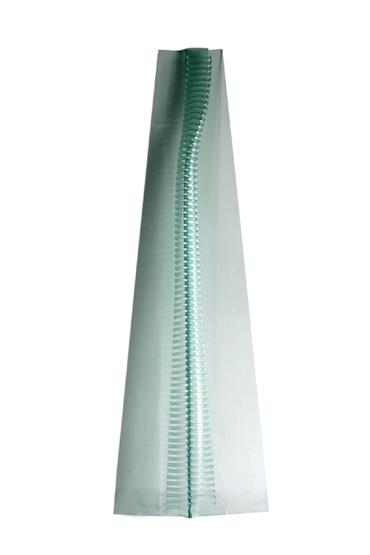
Cutler’s love of waterjet technology has seen her attend conferences designed specifically for engineers using the equipment for industry. She explained how she understood the flow of the seminars through her experience with the machines and how she was aware of any problems with them according to the sounds that it made.
Her experience with the technology has resulted in her ability to assist other artists in their progression. Through her aid, she has opened up her availability and become even better known in the art world.
Cutler was keen to express the importance of speaking to people. She stated that without her dialogue with lots of software companies, engineers both locally and internationally, she would not be where she is today.
“Mayday mayday” – waterjet cut glass 2008
Her international links resulted in her residency in the United States where she was able to further her knowledge of waterjet technology. She states that her work is a result of her own interpretations of the received briefs along with working with other people.
Cutler showed a passion for teaching and research of glass. Her arrival back in Swansea saw her move directly into a teaching role where she focussed on getting her students to incorporate technology into their artwork. The way she spoke of treating her students as working artists to assist them to create professional work was endearing. Through the use of scaled models and templates, Cutler suggests your own work can be made more professional looking than without. She showed slides of some of the work created by her students, expressing a sense of pride and accomplishment. Cutler’s influence upon her class allows them to get on with their work under her guidance whilst they discover their own information. She suggested that teaching allows you to reflect on your own practice as well as continuing to learn.
Again, Cutler’s connections within the world of waterjet technology have paid off and many conferences now include a creative and artist involvement section to show the development of the technology for artists.
When invited to write a book, Cutler was able to cover all the work she has created and helped to create for others. Her aim was to inform the reader how a machine made for a function can also be used to create while testing the parameters and developing an aesthetic.
Cutler’s latest work for the Creative Wales Award, ‘Breathe’ is intended to be a break from helping other artists achieve their creativity, in order to focus on her own process and bring everything she has learned together. She talked about her desire to reconnect to her materials and explore machinery, drawing and dialogue with others. Admirably she states that with this project she hopes to push herself and her work with a degree of selfishness, hoping that the journey itself will create the outcome.
Vanessa Cutler shows great passion for her medium and her practice. Her level of commitment to the technology is fascinating and yet she appears to remain so grounded in her processes.

